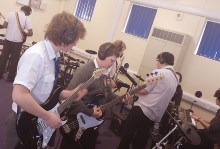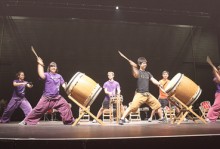In 2007 my life changed, as a musician, teacher and man. How did it happen? One word: Taiko. I took my first steps in this medium of Japanese drumming on the side of a Scottish hill not far from Strathaven. My tutors were leading European Taiko group, Mugenkyo. At the end of that first weekend of intense tuition I knew I had experienced something extraordinary.Performance, rhythmic understanding and discipline form the back bone of Taiko, but they are delivered in such a fashion that you do not realise that is what you are learning. Taiko is also very physical so wonderful for keeping fit. Choreography forms a huge part of any performance but it is performed in such a way that the girls think they are dancing and the boys think they are undertaking martial arts!Over the last five years I have delivered Taiko to students of every age, from KS1 to adult groups. The reward is immediate, the attainment is fast and best of all learning Taiko prepares you for life as a musician, no matter what your instrument. Think about it, performance, rhythmic understanding and discipline, if we could instil those values in every young musician our bands and orchestras would be better places. Now we can, welcome to my world, welcome to Taiko!
Session 1
The amazing thing about Taiko is it can be performed with or without drums. You can just adopt the Taiko stance, play the air and speak the rhythms. I know that sounds crazy but I have led groups in performances this way with amazing effect. Trust me, it works! Session 1 is structured to be delivered playing air drums:
Split your performers into two equal groups:
Group 1 should stand in a straight line side by side
- Ensure they have an arms length space each side o Group 2 should do the same as the above
Group 2 should now stand behind group one
- Ensure you leave an arms length between group 1 and 2
Ask your new Taiko group to put their arms out in front of them
- Not straight but slightly curved at the elbow creating an oval shape
They should now imagine they have paint brushes in each hand
- They should paint an imaginary wall by moving each arm up and down
- Start with the right then left
- As the right is coming down the left should be coming up
- Ensure the strokes flow and are even
As they make make each stroke on their drum the students should say out loud, ‘Don’
- So a right (R), left (L), right (R), left (L) hand movement would sound like:
- ‘Don’ ‘Don’ ‘Don’ ‘Don’
Challenge: The Taiko Stance
For me this is the key to it all. Taiko performers adopt a martial arts stance. This lowers their centre of gravity and allows the performer to play with great power and precision. I also have found the groups that stand right inevitably look more authentic. So how do we do it?
Each student should undertake the following to succeed!
- Put your feet slightly wider than shoulder width apart
- Place your left foot forward half a step and point your foot a little to the left o Place your right foot diagonally backwards to the right, positioning your foot however feels most comfortable.
- Your left knee should be bent, your right knee should be slightly bent
Practice this a little before you unveil it to your students. If in doubt have a look on YouTube, you will find loads of Taiko group performances for inspiration and guidance.
Session 1: Ji-Uchi
Ji-Uchi means base rhythm. This pattern sits underneath most Taiko providing a pulse for the performers and a base for their performance. There are three Ji-Uchi:
- Gobu-Gobu – which you have already learnt. In essence it is R,L,R,L repeated, spoken this would be ‘Don’ ‘Don’ ‘Don’ ‘Don’
- Satchi-San – a more advanced swung rhythm, spoken this would be ‘Don-go’ ‘Don- go’ ‘Don-go’ ‘Don-go’
- Mitsi-uchi – which we will focus on now
Instruct the group to say out loud their initial pattern played earlier
- ‘Don’ ‘Don’ ‘Don’ ‘Don’
- We now need to add a quicker pattern still sticked R, L
- If we think of ‘Don’ as slow, a quicker pattern is spoken as ‘Doko’
The spoken pattern would be:
- ‘Don Doko’ ‘Don Doko’ ‘Don Doko’ ‘Don Doko’
- Speak this pattern through as a group ensuring everyone says it together Now try playing this pattern on your air drum
Sticking would be:
- R RL, R RL, R RL, R RL
Session 2
You could add drums here or continue working without. If you do add drums, 14 or 16’’ Floor toms work perfectly with Vic Firth Alex Acuna Signature sticks.
- Get your group back into their 2 groups, ensure drumming partners stay the same
- If you have an odd number you could fill in as that students partner
- Pair up any students who’s partners are missing
Practice getting into your Taiko stance
- Once you have refreshed the groups memory, introduce a signal so the group go into stance together
- You should signal this process by saying out loud ‘Hup’
Practice getting out of your stance, you will need to do this at the end of your performance o You should signal getting out of stance by saying ‘Sup’
- Practice getting in and out of stance 2 or 3 times
- Revisit your ‘Don’ ‘Don’ ‘Don’ ‘Don’ patternChallenge – Get Ready!
Challenge: Get ready!
Prior to beginning any performance musicians need to know when to start.
In Taiko this is done in a very specific and exciting way:
- Get your group into stance
- Before you start any piece, you will shout ‘One’ ‘Two’
- The group will respond with a ‘So-re!’ (Pronounced sore ray)
- Practice this call and response
- Now introduce some choreography
As the group shouts ‘So’ they should thrust their hands forwards
As the group shouts ‘Re’ they should lift their hands above their heads
Practice this process three or four times:
- Get into stance with a ‘Hup’
- Start your pattern with ‘One’ ‘Two’ ‘So-re’
- Play 16 ‘Don’ beats
- Get out of stance with a ‘Sup’
Session 3
- Get back into your performance groups
- Practice getting in stance and beginning your ‘Don’ pattern
- Practice getting out of stance
Challenge: Learning your first piece
Taiko is traditional learnt with words not notation. You can easily translate the words to notation after a terms work, but for now let’s focus on the words of your first piece, ‘Matsumoto’.
Write on the board the following:
- Don Don Don Ki
- R L R X
- Doko Doko Don Ki
- RL RL R X
Ask the group to speak through the words ensuring you start the group off with:
- ‘One’ ‘Two’ ‘So-re’
- If you struggle with the speed of the notes think of Don as slow and doko as quicker
- Slow Slow Slow Ki
- Quicker Quicker Slow Ki
- Ki is a clap of the hands or a click of your sticks above your head
- Now try getting into stance and playing the piece through properl
- Remember the choreography on ‘So-re’
Once the above feels comfortable, swap the groups around so everyone gets a chance to try the new rhythm.
Session 4
- Get back into your performance groups and recap lesson 3
- Make sure everyone is saying their rhythms clearly and out loud
- Whilst these words should not be shouted, performers should imagine they are a Sumo wrestler and speak firmly with conviction
Challenge: Matsumoto
Write on the board:
- Don Don Don Ki Doko Doko Don Ki
- R L R X RL RL R X
- Don Don Don Ki Doko Doko Don Ki
- R L R X RL RL R X
The group should say the rhythm through a couple of times before:
- Getting into stance in the usual way
- Performing the piece whilst playing their air drums How add the final section to your piece on the board:
- Doko Doko Doko Don Ki Ki Ki Ha!
- RL RL RL R X X X Y
The group should now try speaking through this new section on its own, once they feel comfortable:
- The ‘Ha’ is a very common ending to Taiko
- Performers should say ‘Ha’ whilst putting their arms above their heads in a ‘Y’ (Think YMCA!)
- Now try playing through on your air drums this new section
- Finish with a couple of plays through the whole piece
Session 5
Write the whole of ‘Matsumoto’ up on the board for all to see
- Don Don Don Ki Doko Doko Don Ki
- R L R X RL RL R X
- Don Don Don Ki Doko Doko Don Ki
- R L R X RL RL R X
- Doko Doko Doko Don
- RL RL RL R
- Ki Ki Ki Ha
- X X X Y
- Speak through the piece twice
- Get into stance and perform
- Try to look out for matched movements from each performer
- Ensure everyone speaks with conviction
Performing Matsumoto
You should now arrange a performance whether it be for other students or parents and friends. To truly embed the learning and before moving on, your first performance as a group is vital. Prior to starting your performance if possible walk the drummers in after the audience has sat down. Ensure they process in and line up slowly and precisely. They should face forward and not acknowledge anyone other than you. This process is called finding your ‘Kata’ (Spirit). I find it builds up a real sense of performance and expectation from the audience. Once you have performed your drummers should not break their concentration or stance until you say ‘Sup’. They should then reform into their lines and if appropriate take a bow, you could signal this with another ‘Hup’.
Taiko is the perfect medium to start any musical journey. These five lessons work perfectly as a standalone block or as a starter before moving onto more advanced work. A search on the internet should take you too many more resources. Taiko changed my life, trust me and give it a try, I know you will be surprised at the outcomes…
Dan Jones is Managing Director if Mix Music Education and a former Music Teacher of the Year. Taiko forms a key element to the award winning JamPod™ program. The ClassTaiko program was featured at the 2014 Music Education Expo at the Barbican in London. Find more Taiko resources here.








